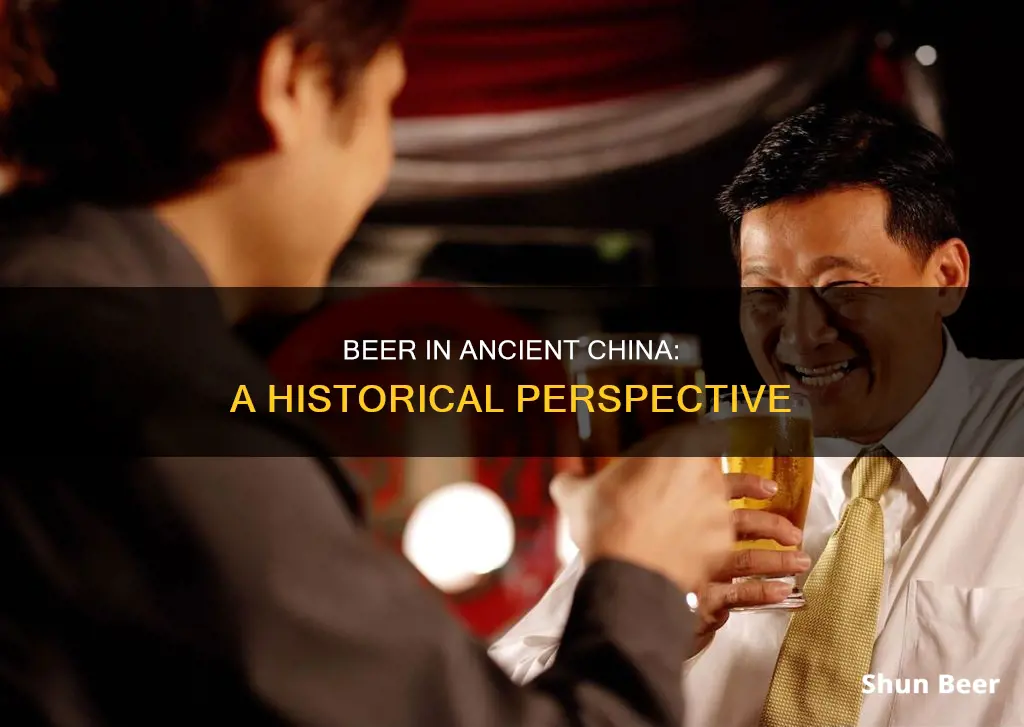
Alcohol consumption in China has increased by 70% since 1990, and the country is expected to surpass the US for per capita intake by 2030. China has a rich and complex history with alcohol, with long-established traditions and etiquette when it comes to drinking. The earliest chemically confirmed alcoholic beverage in the world was discovered in China and dates back to 7000-6600 BC. The drink was made from wild grapes, hawthorn, rice, and honey. Today, the most popular alcoholic drinks in China include wine, beer, whisky, and various liquors, including the world's most-consumed distilled spirit, baijiu.
What You'll Learn

The Chinese invented alcohol
Alcohol has been a part of Chinese culture for thousands of years, with the earliest chemically confirmed alcoholic beverage in the world discovered in the country. The Chinese invented alcohol, with a 9,000-year-old history of brewing drinks.
The earliest evidence of alcohol in China was discovered in Jiahu, Henan Province, and dates back to 7000 BCE. People brewed a drink from rice, honey, grapes, and hawthorn fruit, in a similar way to that of Mesopotamia and Ancient Egypt. This ancient beverage is believed to have been used to transcend reality and connect with the spirit realm, communing with the gods and the dead.
As Chinese civilization evolved, wine became highly prized. Kings maintained court brewers to craft drinks that served as diplomatic tools, helping to forge friendships and win over enemies. During this period, a grain alcohol fermented from naturally harvested yeast emerged as the most popular drink, and it was called jiu.
Alcohol played a significant role in the social, economic, spiritual, and political arenas of ancient Chinese cultures. It was integral to rituals and competitive feasting and may have been a motivating factor for the development of the early agricultural economy. Alcohol was also used in medicine, with various alcoholic drinks being associated with yin in traditional Chinese medicine.
By the first millennium CE, the Chinese kingdoms had united into a vast empire, and huangjiu, a sweet grain wine, became the dominant alcoholic beverage. Drinking became a secular activity, with Confucianists advocating for moderation and Daoists preaching enlightenment through drunkenness. The poet Li Bai is renowned for transforming solitary drinking into a raucous communion with the moon and shadows.
During the Ming Dynasty (1368-1644), distillation techniques were incorporated, and the essence of huangjiu was extracted to create a potent drink called shaojiu or "burnt wine," which later became known as baijiu. Baijiu spread throughout the empire, adapting to local tastes and traditions, and it remains the most-consumed distilled spirit in the world today.
In modern times, China's wine and spirits market has experienced rapid growth, with prestigious international brands gaining a foothold in the country. Alcohol consumption in China has increased significantly, with a 70% rise in per capita intake since 1990. By 2030, China is projected to surpass the US in per capita alcohol consumption.
Beer Drinking on New Jersey Transit: What's Allowed?
You may want to see also

Alcohol is a big part of Chinese socialising
The consumption of alcohol in China is usually social or celebratory and has been an integral part of Chinese culture. The famous Chinese proverb, "酒逢知己千杯少" (jiǔ féng zhījǐ qiān bēi shǎo), translates to "with a close friend, a thousand cups of wine is far too little", encapsulating the role of alcohol in Chinese society. Drinking has long been a way to actively build and foster relationships, whether with friends, family, partners, or even in professional settings.
Alcohol is commonly consumed during group meals and other social events, such as KTV, business functions, weddings, and birthday celebrations. It is also used to mark special occasions, such as the Chinese New Year, the Mid-Autumn Moon Festival, and other festivals. People gather around tables, enjoying food and drinking together.
The drinking culture in China differs from that of Western countries. In Western culture, a greater emphasis is often placed on the beverage itself, with wine-tasting and extensive wine lists being common features of social events. In contrast, Chinese drinking culture places more importance on the people involved. Who you drink with is considered more significant than the drink itself.
Baijiu, a clear liquor distilled from sorghum, is the most popular alcohol in China and is a staple at any social function. It has a strong alcoholic content, typically around 40-60% ABV, and is usually served neat in small glasses. It is enjoyed at room temperature and often paired with food or side dishes.
Other popular alcoholic beverages in China include red wine, beer, and various speciality alcohols, such as huangjiu (yellow wine) and whisky. Beer, in particular, has gained significant traction, with the best-selling beer worldwide being Chinese—Snow. The craft beer industry is also experiencing rapid growth, with Beijing and Shanghai at the forefront of this movement.
Drinking etiquette in China is an important aspect of socialising. Toasts and cheers, often accompanied by the term "ganbei" ("cheers" or "bottoms up"), are a common feature of drinking culture. It is considered rude to refuse a drink or not to drink after a toast, as it signifies respect and sincerity. Additionally, drinking games are a popular element of social gatherings, adding to the festive atmosphere.
Overall, alcohol plays a significant role in Chinese socialising, bringing people together and strengthening relationships. The consumption of alcohol is deeply intertwined with Chinese culture, traditions, and celebrations, making it an integral part of social interactions in the country.
Beer After Food Poisoning: Is It Safe?
You may want to see also

China's best-selling beer is the world's best-selling beer
Alcohol consumption in China has increased by 70% since 1990, and by 2030, Chinese adults are projected to drink more alcohol per capita than Americans. China has a rich history of alcoholic drinks, including rice and grape wine, beer, whisky, and various liquors. One of the most popular alcoholic drinks in China is beer, and the country's best-selling beer brand, Snow, is also the world's best-selling beer.
Snow beer is a pale lager brewed by China Resources Breweries, a joint venture between SABMiller and China Resources Enterprises. It was first released in 1993 and is now available in over 90 breweries across China, producing more than 10 gigalitres of Snow annually. Snow beer is cheap and ubiquitous in China, and while it may not have a strong flavour, it is tough to beat in terms of accessibility and price. China Resources, the company that brews Snow, commands almost 25% of the country's beer market.
In 2022, Snow beer accounted for approximately 31.1% of the beer market in China, with Tsingtao coming in second place with around 22.6% of the market share. Tsingtao, founded by Germans in the early 1900s, is now owned by the Chinese government and is the only Chinese beer brand that has gained popularity with drinkers outside of China.
The popularity of beer in China can be attributed to its social and celebratory nature, often consumed during group meals, social events, and special occasions. Drinking is an integral part of Chinese culture, seen as a way to build and maintain relationships, and beer, being a lighter alcoholic beverage, is often preferred over stronger drinks like baijiu.
China's growing thirst for alcohol has contributed to the rise in global alcohol consumption, and with per capita intake expected to continue increasing, China's beer market, led by Snow beer, will likely remain a significant player in the global beer industry.
Beer and Covid 19: What's Safe to Drink?
You may want to see also

Baijiu is China's most popular alcohol
China has a rich and complex history with alcohol, and drinking has long been a way to actively build relationships in Chinese society and culture. The country's national drink, Baijiu, is the most popular alcohol in China and the world's bestselling liquor. In 2018, 10.8 billion litres were sold, more than whisky, vodka, gin, rum and tequila combined.
Baijiu is a clear, colourless Chinese liquor with an alcohol content of between 35% and 60%. It is typically distilled from fermented sorghum, although other grains such as rice, glutinous rice, wheat, barley, millet, or Job's tears can be used. The drink is usually served neat at room temperature in small cups or glasses, and drunk with food.
There are four widely recognised flavour types: rice, light, strong, and sauce. However, there is a wide spectrum of flavours, from floral and fruity to savoury and spiced. The drink is known for its pungent, distinctive aroma and taste.
Baijiu is an integral part of Chinese drinking etiquette and hospitality. It is considered rude not to drink if someone offers a toast, and it is customary for the host or friends to refill each other's glasses to the brim whenever a glass is empty or a toast has been made.
Beer and Rudraksha: A Spiritual Conundrum?
You may want to see also

Drinking etiquette in China
Ganbei Culture
"Ganbei" is the Chinese equivalent of "cheers", but it literally translates to "empty cup" and is used to encourage guests to finish their entire glass. It is considered rude to refuse a ganbei or not to drink at all when offered a toast. However, it is not necessary to finish the entire beverage, although it would be appreciated. If you are unable to finish your drink, you can say "Peng Bei", which also means "cheers".
Respect and Hierarchy
Drinking is a way to show respect and formality in China. When making a toast, it is respectful to use the right hand and keep the glass at a lower position than others, especially when toasting with someone of higher status. For added formality, the left hand can be placed underneath the cup. When receiving or offering a glass of alcohol, it is customary to use both hands. It is also considered respectful to hold the glass with one hand propping up the bottom, preventing it from being dropped.
Refilling Glasses
In China, it is customary for the host or friends to automatically refill each other's glasses to the brim whenever a glass is empty or a toast has been made, even if it is not requested. Generally, younger drinkers should refill the glasses of older individuals or those who outrank them.
Drinking as a Social Activity
Drinking alcohol is a social activity in China and is often used to strengthen friendships and build relationships, whether with friends, family, partners, or professional relationships. It is common for acquaintances to get together for drinks after work or school.
Drinking Limitations
While drinking is a significant part of Chinese culture, it is not mandatory. If you have drinking limitations, it is considered polite to establish them at the beginning of the meal. You can politely express a low capacity for alcohol intake by saying "我酒量不好 (wǒ jiǔliàng bùhǎo)". Alternatively, you can switch to a lighter beverage such as beer or non-alcoholic drinks, or use tea as a substitute for alcohol.
Beer Drinking: A Relaxing Indulgence or a Health Risk?
You may want to see also
Frequently asked questions
Yes, the Chinese have a long history of drinking beer. In fact, archaeological evidence suggests that early beers were consumed by the neolithic peoples in the area of modern China.
Modern Chinese drinking culture places a heavy emphasis on the social aspect of drinking. Drinking is considered a way to build and maintain relationships, and it is common for acquaintances to get together for drinks after work or school.
Popular drinks in China include beer, wine, and spirits such as baijiu.
In Western culture, a large emphasis is put on the beverage itself, with wine-tasting being a popular form of entertainment. In Chinese culture, the focus is more on the people and drinking is seen as a way to build connections.







